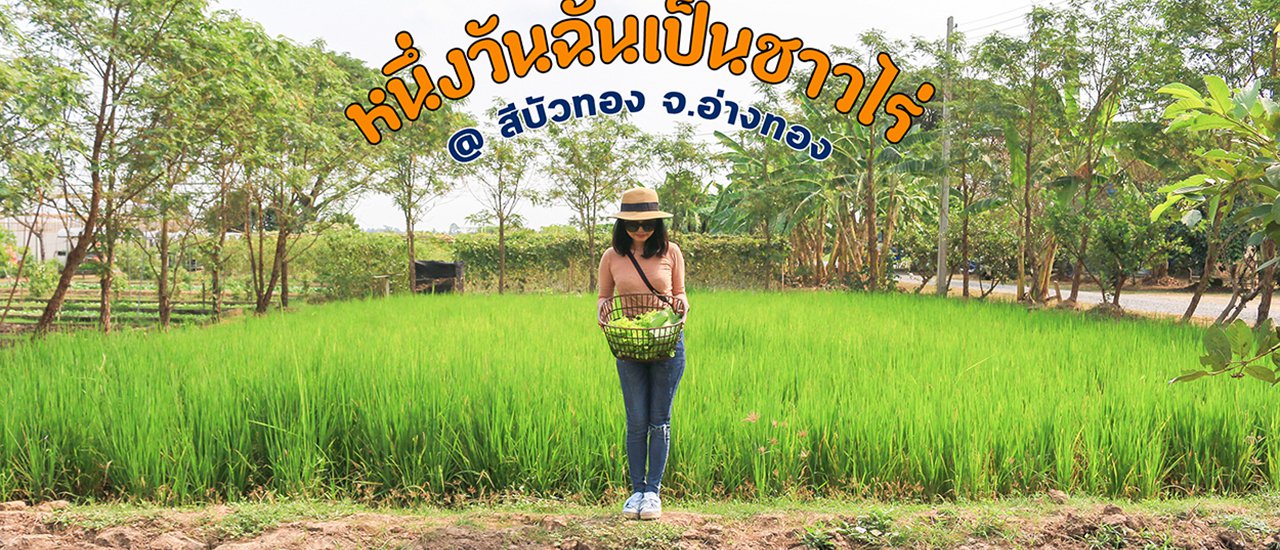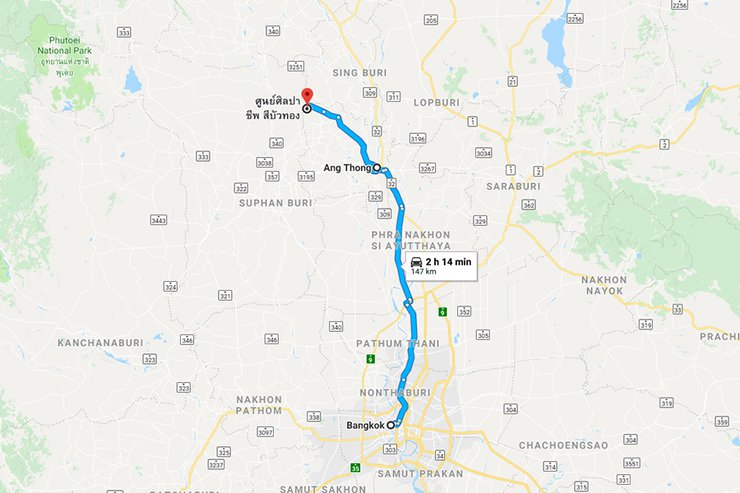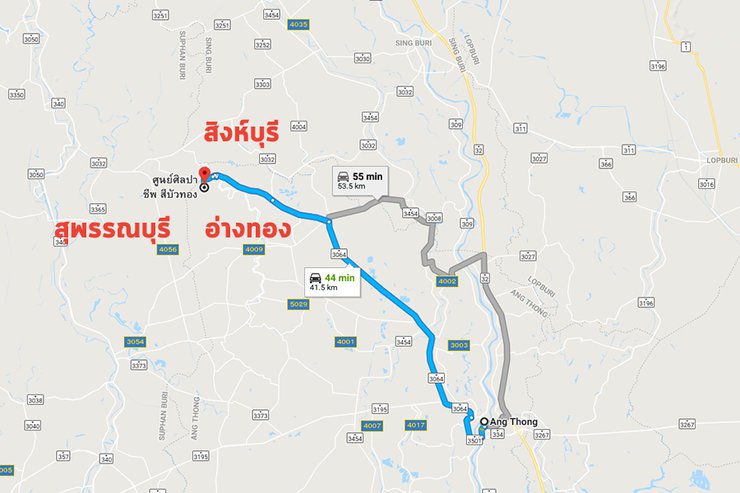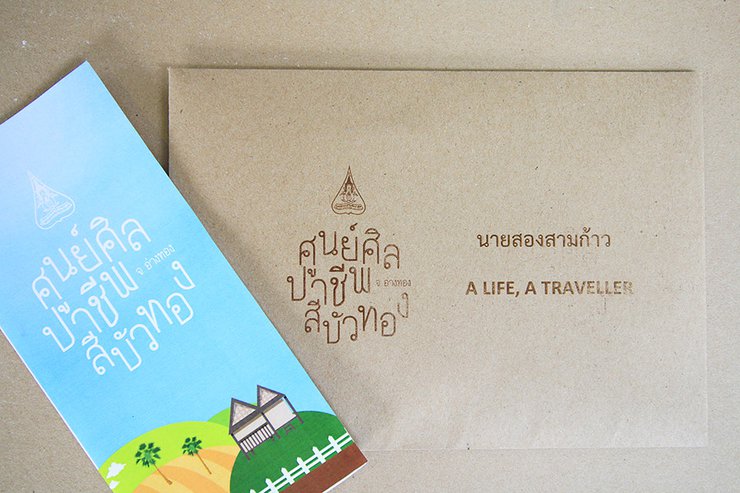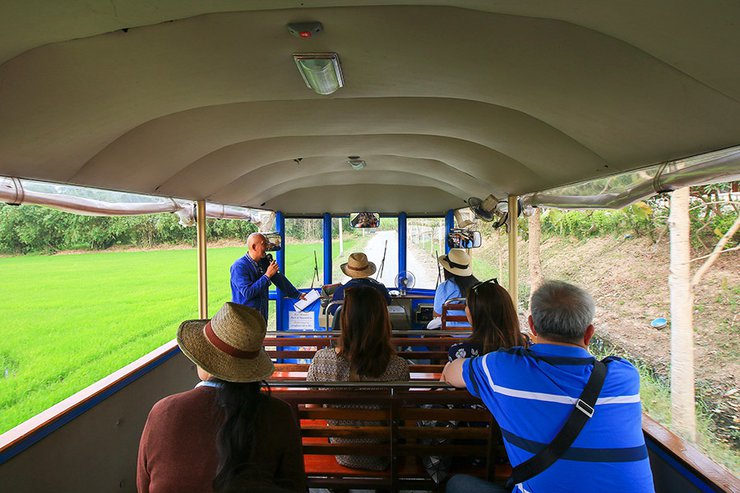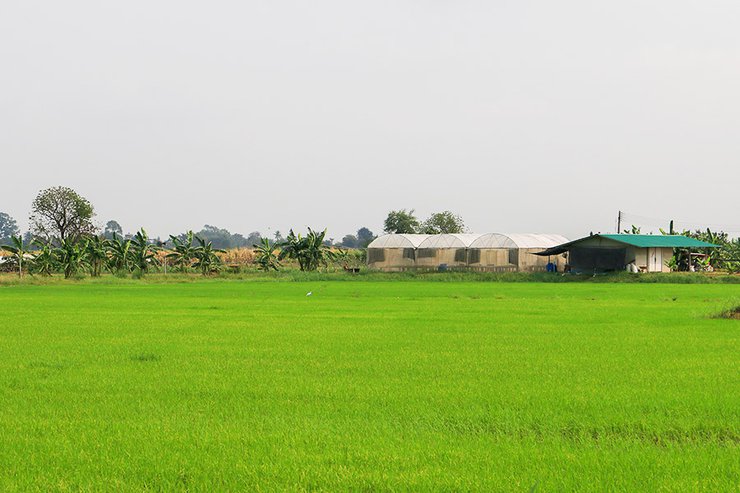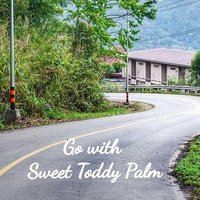Have you ever been to Ang Thong? Please read the question carefully, as there is a difference between "been to" and "passed through." I believe most people would answer that they have only passed through, rather than actually been there. Even I have only passed through myself.
One reason we often overlook Ang Thong is perhaps because it is a large province… larger than just Samut Sakhon, Sing Buri, Nonthaburi, Phuket, and Samut Songkhram, or rather, the sixth smallest province in the country. Its area is less than a million square kilometers, even smaller than Bangkok.
I have had a positive experience in Ang Thong before. I was caught speeding on Asian Highway 32 and fined 400 baht. However, I had never visited Ang Thong before. Therefore, when I received an invitation to visit the Silapacheep Color Bo Thong Arts and Crafts Center and the Royal Initiative Model Farm Project in Ban Yang Klang, Ang Thong Province, last January, I immediately agreed.

The Sib Buathong Handicrafts Center and the Model Farm Project are located in Saenghwa District, about 40 kilometers from Ang Thong city center and about 150 kilometers from Ratchadamnoen Road in Bangkok. It takes just over two hours to drive there. You can set your GPS or, if you are already in Ang Thong city, there will be signs along the way. Don't be alarmed if you see signs indicating that you are approaching Sing Buri or Suphan Buri; this area is located at the intersection of three provinces.

The origin of this place can be traced back to 2006, following a major flood in Ang Thong province. Her Majesty Queen Sirikit had the idea to establish a model agricultural farm to provide shelter for affected residents. Initially, it was set up in Ang Thong town, but due to limited space, it was relocated to Saen Suk district. Currently, both the Silpa-achi Center and the Model Farm Project are located on the same 700-rai plot of land. It serves as a source of income for local residents, a center for disseminating agricultural knowledge, a venue for vocational skills training, and most recently, a new agro-tourism destination in Ang Thong.

The exploration of the activities here began with a presentation on the origin of the project, which I mentioned earlier. Then, we took a tram ride to visit the model farm project, where we saw various agricultural plots, including both permanent and seasonal crops, vegetables, and fruits. The caretakers are local villagers. As the tram passed by, we waved and greeted them with smiles.



During my visit, the mango trees were in full bloom and bearing fruit. The mango orchard offered a pleasant atmosphere.

After completing a farm tour, participants embarked on a visit to a demonstration agricultural plot. The activity-packed session commenced with planting salad vegetables in pots using earthworm manure fertilizer. Notably, a demonstration on how to make earthworm manure was provided. Remarkably, these seemingly insignificant earthworms serve as a true indicator of soil quality.



After planting the vegetables, we went to harvest them. (Wait… what?) The farm has a pesticide-free vegetable plot where we can pick fresh vegetables. Salad greens, Chinese kale, and various other vegetables, all plump and leafy, are available for you to cut and put in your basket as you like. They only cost ten baht each. Then wash them and put them in a bag to take home.



A vegetable farm is often paired with a fish and frog pond, where they are raised well from tadpoles to large, hand-sized frogs. Seeing their cute eyes makes me want to break their legs and stir-fry them (lol...). But now, after many days, I wonder if they have reached their final destination in someone's stomach yet.


In this section, children are demonstrating the creation of art from natural materials. Lotus stems are used as paintbrushes, and the colors are derived from plants such as butterfly pea flowers, winter melon, eggplant, mulberry (locally known as mulberry fruit), and marigolds. If children were to visit, they would surely have a lot of fun.

Traditional snacks, "Khao Krok" (crispy coconut pancakes) and "Itim Lod" (ice cream in a tube), bring back childhood memories. Anyone who was a teenager in the 90s, please report immediately (lol...). But here, they don't use soda water, instead they use various vegetable and fruit juices or herbal plants. That's right, the taste is guaranteed to be just as delicious.


A tour through the vegetable plots and mushroom cultivation facilities, showcasing the cultivation process of Bhutanese oyster mushrooms, Hungarian oyster mushrooms, and lingzhi mushrooms. The first two varieties allow visitors to handpick their preferred mushrooms, offering a unique and affordable experience.




After harvesting vegetables and mushrooms, we almost slaughtered the frogs… (Just kidding, we released them back into the pond). Next, we changed the atmosphere to a livestock farm to feed the goats in a fun way. This farm raises two types of animals: goats and Jinhua pigs, which are a breed imported from China. However, raising pigs is not very aesthetically pleasing, so we will just stick to raising goats.


It was lunchtime, and it was time to eat. Almost all of the food was farm-fresh produce (thankfully, the two giant toads were not there, or I would have eaten with a guilty conscience). The set was served in a cute Thai-style tiffin carrier, but I should mention that they don't prepare this way for everyone who visits. If you come as a group or a study tour, you need to contact them in advance, and they will be able to prepare it for you. There is an additional cost involved, of course.


After a satisfying meal, continue exploring the farm. Another highlight of the model farm project is the orchid. The atmosphere inside the breeding house is pleasant and shady. In addition to walking around and taking pictures, if you want to buy any plants or flowers, please inform the staff.



Don't spend all your money on orchids! Save some to support the vegetable farmers too. You won't find prices like this anywhere else. When we went, mangoes were 50 baht per kilo, large bags of mushrooms were 20 baht, and various vegetables were 10-20 baht per bunch. We had a great time shopping and knowing that everything was pesticide-free.

These are all the activities we had the opportunity to participate in at the Royal Project Farm Model at Ban Yang Klang. In reality, there is much more to see and do. You can stroll through the agricultural plots, the gardens, and the various crop fields. You can also choose to buy various plants that the farm has prepared for sale to tourists. Additionally, there is a forest planting area where you can walk and study nature.
It's time to visit the Sib Buathong Handicrafts Center, which is located in the same area as the other attractions. It is a large building with a prominent three-headed elephant statue at the front.

"Hmm, what are they doing?" This is the question that almost everyone who walks in asks themselves. Inside the center, there are four main occupational sections. The first is the production of mulberry paper and Khon masks. The next is the weaving of silk brocade. Then, there is the embroidery of Khon costumes. Finally, there is the production of ceramic glaze."
In addition to providing career opportunities, the center serves as a training ground for skilled craftsmen. Many of the center's graduates were part of the team that built the royal crematorium for His Majesty King Bhumibol Adulyadej, a replica of which is on display at the center.



The Sib Buathong Handicrafts Center emphasizes traditional methods for mask-making, starting with the ancient process of producing mulberry paper. The bark of the mulberry tree is shredded, fermented, pounded, treated with chemicals, and dried to create paper. The paper is then used to draw and carve patterns, and the masks are shaped with meticulous care and skill.



The intricate embroidery on the Khon costumes is a testament to the dedication and meticulousness of the artisans. Each exquisite design is painstakingly crafted, stitch by stitch, over countless hours. The slow and steady progress of their work reflects their unwavering commitment to preserving this traditional art form.


The weaving of silk brocade requires considerable skill and expertise. The intricate patterns and fine texture of the fabric are a testament to the craftsmanship involved. The center is committed to passing on this knowledge to future generations.


The production of ceramic glazed products is a significant source of income for this area. Both the equipment and the skilled workers are readily available, suggesting that there is potential for further development in the future.


The activity that we truly engaged in was painting ceramic patterns, creating unique coffee cups and coasters. Seeing the villagers' intricate designs, I must admit defeat, as my artistic skills have undoubtedly failed (haha...).


Here is the translation of the text:
The cost for this service is 400 baht. After we finish painting, the center will bake it according to the process. It will then be sent to your home via post.


It took from around nine in the morning until almost four in the afternoon to complete the tour of the Sib Buathong Handicrafts Center and the Royal Initiative Farm Project in Ban Yang Klang. I must say that it was a day filled with learning and new experiences. Most importantly, it made us realize that visiting handicraft exhibitions and agricultural tourism is not boring at all. In fact, we enjoyed every activity we participated in.
The Sib Buathong Arts and Crafts Center and the Model Farm Project are still in their early stages of development for tourism. The facilities are not yet fully operational and are currently managed by teachers and local residents. Visitors are welcome to explore the grounds, but those who wish to participate in full activities must make arrangements in advance. Updates and contact information can be found on the center's Facebook page: www.facebook.com/sibuathongth. More organized programs are expected to be available in the near future.
Let us work together to ensure that this place grows slowly but sustainably, with a shared understanding between visitors and hosts.

In addition to the aforementioned attractions, Ang Thong province boasts a wealth of stunning temples and monasteries, making it an ideal destination for a weekend getaway. During my one-day visit, I had the opportunity to explore Wat Sangkhat Kritai (ancient ubosot with a banyan tree), Wat Khun Inthapramun (temple with a large reclining Buddha), Wat Tha It (temple with a golden pagoda), and Wat Muang (temple with the largest Buddha statue in Thailand). I spent the night at a resort near Wat Muang in Wiset Chai Chan district before driving to the Sib Buathong Handicrafts Center and the Model Farm the next morning.
Ang Thong may be a small province, but after visiting, I was impressed and found it to be much more interesting than I had expected.
Follow my travel adventures on another channel.
http://www.facebook.com/alifeatraveller
นายสองสามก้าว / A Life, A Traveller
Monday, November 11, 2024 10:30 AM

